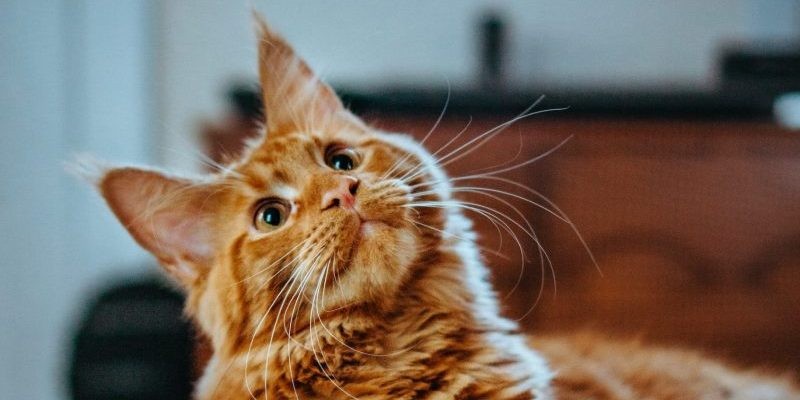Have you ever scrolled through the internet and come across a meme about orange cats being… well, not the brightest bulbs in the box? Maybe you’ve seen videos of ginger felines getting into hilarious mishaps, or perhaps you know an orange cat in real life who seems to be a little bit… quirky. This perception of “orange cat behavior” is widespread, even spawning a popular subreddit dedicated to the supposed single shared brain cell among orange cats. But is there any truth to the stereotype? Are orange cats actually dumber, or is it just a funny internet trope? Let’s dive into the science and shed some light on the intelligence of our marmalade companions.
 A fluffy orange tabby cat looking slightly confused.
A fluffy orange tabby cat looking slightly confused.
Unpacking the Orange Cat: Breed vs. Color
When we talk about orange cats, it’s important to clarify that we’re usually referring to orange tabby cats. “Tabby” describes a coat pattern, not a breed. Think of it like stripes or spots – it’s a design on the fur. Tabby cats are a common coat type found across various breeds and are descended from wildcats from Africa, Europe, and Asia. So, saying “orange cat” isn’t like saying “Persian cat” or “Siamese cat,” it’s more about the color and pattern of their fur.
The distinctive orange hue comes from a pigment called pheomelanin. Most cats produce eumelanin, which results in black or brown fur. Orange cats, however, produce pheomelanin instead, giving them their ginger shades. And here’s a key genetic detail: the gene responsible for this orange color is located on the X chromosome. This sex-linked inheritance plays a significant role in why we see more male orange cats than females.
The Gender Ratio: Why Are Most Orange Cats Male?
Remember high school biology? Female cats have two X chromosomes (XX), while male cats have one X and one Y chromosome (XY). For a female cat to be orange, she needs to inherit the orange gene from both of her parents, meaning both X chromosomes must carry the orange trait. Males, on the other hand, only need to inherit the orange gene from their mother’s X chromosome.
This genetic quirk leads to a significant skew in the gender ratio of orange cats. Around 80% of orange tabby cats are male. If a female cat inherits one orange gene and one non-orange gene, she becomes a tortoiseshell or calico cat, displaying patches of orange mixed with other colors. Tortoiseshell and calico cats are overwhelmingly female due to this X-linked inheritance pattern. Rare male tortoiseshells or calicos do exist, but they are usually sterile due to a chromosomal abnormality.
Debunking the “Dumb Orange Cat” Myth: Is There Any Scientific Basis?
Despite the popular memes and anecdotal evidence, solid scientific research linking coat color to personality or intelligence in cats is scarce. Most of the “proof” for the “dumb orange cat” theory is based on subjective observations and humorous internet content.
One study from 1995 did find that orange cats were more prevalent in rural environments and less common in areas with high mortality risks. While this might seem to suggest that orange cats are less cautious or more prone to risky behaviors, the study itself suggests a more nuanced explanation. The higher prevalence in rural areas could be related to different mating patterns in rural versus urban settings. The lower prevalence in high-risk areas could simply be because orange fur is more visible to predators than darker colors, making them easier targets in the wild.
It’s crucial to acknowledge the power of perception. Research indicates that humans tend to project personality traits onto pets based on their coat color. A 2012 study revealed that orange cats are often perceived as more friendly, while white cats are seen as shy. This bias in perception could easily contribute to the “dumb orange cat” stereotype. If we expect orange cats to be goofy and less intelligent, we might be more likely to interpret their actions in that light, reinforcing the stereotype.
Furthermore, studies have shown that coat color can even influence adoption rates and outcomes for cats. Black and brown cats are sadly less likely to be adopted and have a higher risk of euthanasia, highlighting how superficial traits like coat color can impact a cat’s life.
Conclusion: Personality Beyond Pigment
So, are orange cats actually dumber? The answer, backed by science, is a resounding no. The stereotype is more likely a combination of anecdotal observations, internet humor, and our human tendency to associate certain traits with visual cues like coat color. While genetics do play a role in coat color and even gender distribution, there’s no credible scientific evidence to suggest that the genes responsible for orange fur are also linked to lower intelligence.
The next time you see a meme about a silly orange cat, remember it’s all in good fun. Every cat, regardless of color, is an individual with their own unique personality and quirks. Let’s appreciate orange cats for their vibrant coats and unique personalities, without falling for unfounded stereotypes. Perhaps the real intelligence lies in orange cats for successfully convincing the internet that they share a single brain cell, gaining them endless attention and amusement!
